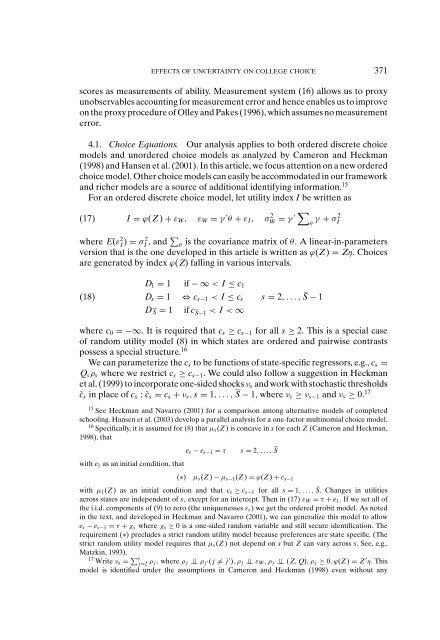Estimating Distributions of Counterfactuals with an Application ... - UCL
Estimating Distributions of Counterfactuals with an Application ... - UCL
Estimating Distributions of Counterfactuals with an Application ... - UCL
Create successful ePaper yourself
Turn your PDF publications into a flip-book with our unique Google optimized e-Paper software.
EFFECTS OF UNCERTAINTY ON COLLEGE CHOICE 371<br />
scores as measurements <strong>of</strong> ability. Measurement system (16) allows us to proxy<br />
unobservables accounting for measurement error <strong>an</strong>d hence enables us to improve<br />
on the proxy procedure <strong>of</strong> Olley <strong>an</strong>d Pakes (1996), which assumes no measurement<br />
error.<br />
4.1. Choice Equations. Our <strong>an</strong>alysis applies to both ordered discrete choice<br />
models <strong>an</strong>d unordered choice models as <strong>an</strong>alyzed by Cameron <strong>an</strong>d Heckm<strong>an</strong><br />
(1998) <strong>an</strong>d H<strong>an</strong>sen et al. (2001). In this article, we focus attention on a new ordered<br />
choice model. Other choice models c<strong>an</strong> easily be accommodated in our framework<br />
<strong>an</strong>d richer models are a source <strong>of</strong> additional identifying information. 15<br />
For <strong>an</strong> ordered discrete choice model, let utility index I be written as<br />
(17)<br />
I = ϕ(Z) + ε W , ε W = γ ′ θ + ε I , σ 2 W = γ ′ ∑ θ γ + σ 2 I<br />
where E(ε 2 I ) = σ I 2, <strong>an</strong>d ∑ θ<br />
is the covari<strong>an</strong>ce matrix <strong>of</strong> θ. A linear-in-parameters<br />
version that is the one developed in this article is written as ϕ(Z) = Zη. Choices<br />
are generated by index ϕ(Z) falling in various intervals.<br />
(18)<br />
D 1 = 1 if−∞< I ≤ c 1<br />
D s = 1 ⇔ c s−1 < I ≤ c s s = 2,..., ¯S − 1<br />
D S = 1 ifc S−1 < I < ∞<br />
where c 0 =−∞. It is required that c s ≥ c s−1 for all s ≥ 2. This is a special case<br />
<strong>of</strong> r<strong>an</strong>dom utility model (8) in which states are ordered <strong>an</strong>d pairwise contrasts<br />
possess a special structure. 16<br />
We c<strong>an</strong> parameterize the c s to be functions <strong>of</strong> state-specific regressors, e.g., c s =<br />
Q s ρ s where we restrict c s ≥ c s−1 . We could also follow a suggestion in Heckm<strong>an</strong><br />
et al. (1999) to incorporate one-sided shocks ν s <strong>an</strong>d work <strong>with</strong> stochastic thresholds<br />
˜c s in place <strong>of</strong> c s : ˜c s = c s + ν s , s = 1,...,S − 1, where ν s ≥ ν s−1 <strong>an</strong>d ν s ≥ 0. 17<br />
15 See Heckm<strong>an</strong> <strong>an</strong>d Navarro (2001) for a comparison among alternative models <strong>of</strong> completed<br />
schooling. H<strong>an</strong>sen et al. (2003) develop a parallel <strong>an</strong>alysis for a one-factor multinomial choice model.<br />
16 Specifically, it is assumed for (8) that µ s (Z ) is concave in s for each Z (Cameron <strong>an</strong>d Heckm<strong>an</strong>,<br />
1998), that<br />
e s − e s−1 = τ s = 2,...,S<br />
<strong>with</strong> e 1 as <strong>an</strong> initial condition, that<br />
(∗) µ s (Z ) − µ s−1 (Z ) = ϕ(Z ) + c s−1<br />
<strong>with</strong> µ 1 (Z ) as <strong>an</strong> initial condition <strong>an</strong>d that c s ≥ c s−1 for all s = 1,..., ¯S. Ch<strong>an</strong>ges in utilities<br />
across states are independent <strong>of</strong> s, except for <strong>an</strong> intercept. Then in (17) ε W = τ + e 1 . If we set all <strong>of</strong><br />
the i.i.d. components <strong>of</strong> (9) to zero (the uniquenesses ε s ) we get the ordered probit model. As noted<br />
in the text, <strong>an</strong>d developed in Heckm<strong>an</strong> <strong>an</strong>d Navarro (2001), we c<strong>an</strong> generalize this model to allow<br />
e s − e s−1 = τ + χ s where χ s ≥ 0 is a one-sided r<strong>an</strong>dom variable <strong>an</strong>d still secure identification. The<br />
requirement (∗) precludes a strict r<strong>an</strong>dom utility model because preferences are state specific. (The<br />
strict r<strong>an</strong>dom utility model requires that µ s (Z ) not depend on s but Z c<strong>an</strong> vary across s. See, e.g.,<br />
Matzkin, 1993).<br />
17 Write ν s = ∑ s<br />
j=2 ρ j , where ρ j ⊥ ρ j ′( j ≠ j ′ ),ρ j ⊥ ε W ,ρ j ⊥ (Z, Q),ρ j ≥ 0,ϕ(Z ) = Z ′ η. This<br />
model is identified under the assumptions in Cameron <strong>an</strong>d Heckm<strong>an</strong> (1998) even <strong>with</strong>out <strong>an</strong>y
















